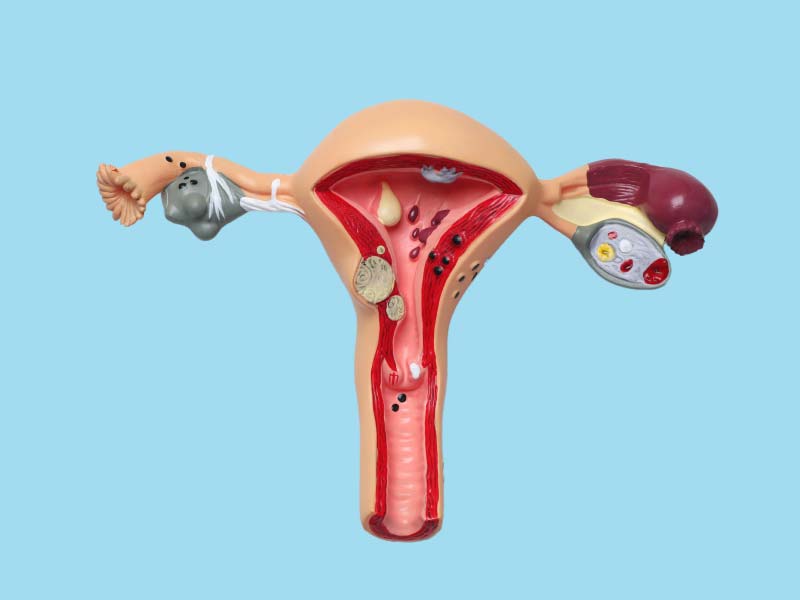
I'm Getting My First
Pelvic Exam, What Should I Expect?
By Lizzie De La Cruz
May 25, 2021
Pelvic Examination
When I remember my first pelvic exam, all I remember thinking about was how the doctor was going to inspect all of me—you know, all of me. The variety of metal tools and swabs on the table definitely did not help my anxiety either. It's easy to get nervous going to the doctor in any situation, but I get becoming extra nervous when the whole appointment is about your vagina. Now that I know and understand what to expect at my yearly wellness exam, I can confidently say there's nothing to worry about! Read on for tips and what to expect for your next pelvic exam.
What's a Pelvic Exam?
If you're a human with a vagina, a pelvic exam is just a regular part of your wellness exam. The CDC recommends most women start getting Pap tests at 21 to screen for cervical cancer and HPV, and this process typically involves a full or partial pelvic exam. You may go for your first pelvic exam before 21 if you're having certain symptoms or you're looking to get a prescription for birth control. Although pelvic exams are not required to access the birth control pill, policies may differ depending on the doctor you see. If you're having trouble getting in to see a medical provider in person for a pelvic exam, or you feel you aren't ready for one, you can always order birth control through Wisp.
It's totally normal to feel nervous before your first pelvic examination, but don't worry! These exams only take a few minutes, and they don't hurt (although, yeah, some parts can feel uncomfortable briefly). If something does hurt, tell your doctor or nurse right away so they can help make you more comfortable.
Here are a few tips and tricks to help you feel more relaxed during your exam:
- Take slow, deep breaths.
- Allow your stomach muscles to go soft.
- Relax your muscles, including your shoulders and the muscles between your legs.
- Ask the doctor or nurse performing the examination to describe what they're doing while they do it — as with so many things in life, communication is key.
What Does a Pelvic Exam Consist Of?
During your pelvic exam, a doctor will perform a visual and physical examination of your reproductive organs. Your doctor will inspect your:
- Cervix
- Fallopian tubes
- Ovaries
- Uterus
- Vagina
- Vulva You may also get a Pap test, used to screen for cervical cancer, during your exam.
Reasons for Having a Pelvic Exam
As noted earlier, the CDC recommends that most humans with vaginas receive a Pap test every 3 years from age 21 onwards (and this frequency may change depending on changes to your health) to screen for cervical cancer. These regular wellness checks are a lot like your general checkups with the doctor. However, there are a few special reasons why you might need a pelvic exam beyond that regular schedule, including:
- You're having unusual discharge or vaginal bleeding.
- You have a family history of cancer.
- You're concerned about STIs, cysts, ovarian cancer or other reproductive health issues.
- You want to get an IUD (a form of birth control).
HPV test or Pap test?
Pap tests are part of maintaining your cervical health and preventing cervical cancer, but if you're over the age of 30, you can talk to your doctor about receiving an HPV test, a Pap test, or both (called co-testing). HPV tests look for the presence of Human Papilloma Virus, the virus that can cause the changes in cervical cells that can lead to cancer. If you test negative for HPV, your doctor may recommend a Pap test every 5 years instead of every 3 years.
If you get an abnormal result from your Pap test, don't panic! Abnormal results are common, and don't necessarily mean that you have cancer. Your doctor will provide you with further testing, guidance, and next steps to get your cervix healthy.
What Happens During a Pelvic Exam?
Going in prepared knowing how a pelvic exam is done will help you relax during your first examination. Your doctor or nurse will first give you some time to undress and put on a cloth or paper gown in privacy. Once they return to your room, they'll ask you to lie down on an exam table. You'll need to put your legs up on footrests.
As you slide your hips to the edge of the table, let your knees spread out. Again, try to relax the muscles in your stomach, vaginal area and butt as much as you can. What I like to do before exams is take a few nice, deep breaths before the doctor comes in to calm the nervousness. Being less tense will make the whole experience more comfortable.
A typical pelvic exam may include some or all of the following parts: External exam:The doctor or nurse will take a look at your vulva, as well as the opening of your vagina.
- Speculum exam: Your doctor or nurse will slide a speculum, a medical instrument made of plastic or metal, gently into your vagina. The speculum separates the walls of your vagina. It's going to feel cold at first! But, if it hurts, let your doctor know. Pro-tip: If you're curious to see your cervix, you can ask. Your doctor or nurse may be able to show you with a mirror.
- Bimanual exam: Your doctor or nurse will put one or two fingers (gloved and lubricated first) into your vagina while they gently press down on your lower abdomen with the other hand.
- Rectovaginal exam: Your doctor or nurse might also put a gloved finger in your rectum, possibly putting another finger in your vagina at the same time to inspect the tissue between the rectum and vagina more thoroughly. Pro-tip #2: Don't freak out if you feel like you have to poop at this part of the examination. The feeling is completely normal, and will only last for a few seconds.
Bimanual exams and rectovaginal exams often aren't performed for patients younger than 21 years of age if they aren't experiencing any symptoms—the decision of whether or not to undergo these exams should be made between you and your doctor.
What Does a Pelvic Exam Show?
Each component of a pelvic exam checks aspects of your reproductive health.
External Exam
The external exam checks for signs of:
- Abnormal discharge
- Cysts
- Genital warts
- Irritation
Speculum Exam
The speculum exam includes a few different parts. Once the doctor or nurse inserts the speculum, they'll use a small brush or spatula in your cervix to get a small sample of cells. This sample goes to a lab to screen for pre-cancer or cancer in your cervix. This pelvic exam test is what's known as a Pap test. If you're getting tested for STIs such as gonorrhea or chlamydia or other infections, the doctor or nurse will also take a sample of discharge from your cervix using a cotton swab.
Bimanual Exam
The bimanual exam checks for:
- Enlarged ovaries
- Enlarged Fallopian tubes
- Ovarian cysts
- Tenderness or pain (which could indicate an infection or other condition)
- Tumors
Rectovaginal Exam
The rectovaginal exam checks the muscles between your vagina and anus, and checks for tumors in the following places:
- Behind your uterus
- In your rectum
- On your vagina's lower wall
In combination with information about your medical history and any symptoms you're experiencing, your doctor or nurse can check for pelvic inflammatory disease (PID). This infection of the female reproductive organs is pretty common, and it happens when sexually transmitted bacteria spread from the vagina to the fallopian tubes, ovaries or uterus. Tenderness and swelling can signify PID.
It's so important to bring up any symptoms during your exam, as a proper diagnosis will help you get treatment that gets you feeling better and back to leading your normal life. Treatment for PID can include antibiotics (make sure you take everything prescribed, even if you start feeling better a few days in) for you and your partner or partners.
Knowing what a pelvic examination is will help you feel more at ease when it comes time to do it. Remember: slow, deep breaths, and speak up if something doesn't feel right. Your pelvic exam is essential for keeping track of your overall sexual and reproductive health and may detect life-threatening conditions like infections or cancer before they develop into a bigger problem, so make sure you get one when it's time.


